Azalea flowers - how to care: watering, feeding, pruning and transplanting
Azalea is a decorative flower, loved by gardeners and florists for its lush, beautiful bloom... Its peculiarity is that it blooms, as a rule, by winter, when most of the plants are no longer blooming. Azalea is very good as a birthday present in winter. It is no worse than a festive bouquet.
Content:
- Azalea: features of the structure of flowers and application
- Growing conditions
- Planting and transplanting
- The best species to grow
- Diseases and pests
Azalea: features of the structure of flowers and application
Azalea belongs to the genus Rhododendrons ("pink tree"). It really looks like a miniature tree decorated with roses. Azaleas can be evergreen or deciduous. Depending on the variety, the height varies from half a meter to 3 m. Low-growing plants are used as indoor plants, and tall ones are planted in gardens, parks, front gardens.
Azalea leaves are dense, slightly elongated, dark rich green, slightly pubescent. Flowers differ depending on the variety: flat or funnel-shaped, double or smooth.
The colors are very different: pink, red, lilac, white, color combinations are possible.
Even the smallest indoor varieties resemble a tree or shrub with dense branchy stems. To understand how to grow azalea flowers, how to care for them, you do not need to have rich experience in gardening. Although the plant is considered capricious, it is enough to find the right approach to it, and it will delight the owner for many years.
The birthplace of azaleas is considered to be China, India and Japan. There, this shrub grows naturally. As an ornamental plant, azalea began to be actively used in the 18th century. To this day, azalea is considered a lucky flower in Europe. It is used to decorate tables for Christmas or during a wedding celebration. It is believed that this flower brings good luck and contributes to an increase in prosperity.
There is also a practical use for this decorative flower. For example, some varieties of azaleas are capable of warding off ants and scaring home moths with their aroma. And flower petals are used as a remedy for barley on the eye. To do this, you need to make a bandage and apply the petals to the sore spot for a while.
Growing conditions
As mentioned above, azalea is considered capricious. Care behind it should be regular and thoughtful. For a beginner grower, this process may seem overly complicated.
But following some rules, you can achieve an amazing blooming effect.
Conditions for growing azaleas:
- Watering should be moderate. Azalea does not like dryness or dampness. The soil should be slightly damp, but it should not be brought to the state of sticky mud. Water for irrigation should be preferably soft, and not chlorinated from the tap. Of course, not everyone will collect rainwater, you can simply filter and boil regular water. If the plant does not have enough moisture, it gives a signal by shedding the leaves, the flowers begin to dry out.
- Indoor humidity should always be at a certain level. You can use humidifiers, but it's easier to put a tray of water under the flower.It is especially important to monitor humidity in winter when heating is on and the air in the room is dry. Desirable every day spray leaves from a small squirt.
- Top dressing must be picked up at a specialist store. It is advisable to take only those fertilizersthat say "for azalea" and follow the instructions on them.
- Lighting and temperature conditions must be carefully selected. Azalea is accustomed to coolness and does not like stuffy places near the battery. The ideal conditions for it will be a temperature of 10-15 degrees. Of course, it is very difficult to create such conditions in the summer, for this it is not necessary to use an air conditioner, it is enough to put the flower in the shade in the coolest place in the house. Azalea loves light, but diffused. Do not allow direct sunlight to fall on delicate flowers.
- Pruning azaleas are also needed so that they bloom more luxuriantly and bush properly. The denser the bush and the more shoots, the more flowers. Once the plant has bloomed from May to mid-summer, you need to regularly prune and pinch the azalea. You don't need to undercut everything too much. Only those branches that are too stretched and stand out from the general picture are shortened. For new foliage to appear faster, the pruner must be sharp enough and treated with an antiseptic. After trimming, it is advisable to lubricate each cut with RanNet.
Planting and transplanting
You can plant azaleas not only at home, but also in the garden. Accustomed to cold weather, they can safely survive frosts down to -27 degrees. If the home azalea can be rearranged in a shaded area, then the garden azalea should grow immediately in suitable conditions. Usually it is planted in places with partial shade or under sparse trees.
The capricious azalea blooms well only on specially selected soil. It is desirable that it be sour, rather loose, with a content of peat and sand. To make things easier for yourself, you can purchase azalea soil from a specialized store.
It is usually not seeds that are planted in open ground, but seedlings.
Shallow pits are made, at the bottom of which there must be drainage. If the bush is large, the hole should be at least half a meter deep, and drainage should take 20 cm. Lime drainages should not be used, they reduce the acidity of the soil. The soil around the seedlings is desirable mulch needles or leaves to keep moisture in it longer. In addition, it will slow down growth. weeds, and protects the roots from freezing.
Before boarding seed (for seedlings or just for potted cultivation), make sure there is stock. Not all seeds will sprout; therefore, to create a composition, it is better to play it safe, plant more often and then thin out the flowers. Even at the germination stage seed Azalea needs light, so it is better to put the pots in sunny places. You do not need to plant seeds deeply, they are placed on the surface and slightly sprinkled with soil. Then the box or pot is covered with transparent wrap. If it is open ground, you need to make a small greenhouse.
Flower Transplant Tips:
- If the azalea has grown and you need it transplant in another pot, for example, after shopping in a store, it is better to leave it until spring.
- Perfect time for transplants - March, when the plant has already bloomed.
- The soil should be the same as last time, acidic and specially selected.
- You need to transplant the azalea along with a lump of earth around the root.
- First, you need to moisten the soil, dig in and carefully pull out the flower.
- An azalea is placed in a pre-prepared hole along with a lump of soil and carefully sprinkled on the sides with earth.
The transplant process has been completed. After that, you can water and cut it a little more.
The best species to grow
Azalea has many types and varieties. All of them differ in their decorative qualities, care, flowering period. Each species has its own varieties. When choosing a variety, one should pay attention to its characteristics, climatic preferences.Common varieties of azaleas:
- Japanese azalea. This type of azalea has many different varieties. It can be grown both at home and outdoors. The flowers are not flat, but similar to funnels, about 3 cm in diameter, medium-sized, but quite bright and richly blooming. The colors are very different: white, red, lilac, pink. In Japan, this plant is no less popular than sakura. It can be found in almost any Japanese garden. If you plant it in open ground, then it is desirable in regions with a mild climate, it may not survive severe frosts.
- Indian azalea. The most common indoor azalea species. It is more difficult to grow it outdoors, since this flower is used to moisture and coolness. The flowers are larger than those of the Japanese variety, up to 5 cm, the colors are white, yellow, pink, red, bicolor. There are double and non-double varieties. It blooms for a long time, all winter, spring and part of summer. He is not afraid of low temperatures, but he does not like stuffy hot rooms especially in winter during the heating period. In this case, it is better to put it on a windowsill on a heated glazed balcony or another cool place.
- Azalea is white. Very beautiful bushresembling flowers jasmine... Most often it is grown in gardens and front gardens. It usually reaches a height of half a meter, the flowers are white or slightly pinkish. These unique flowers can change color like a chameleon when planted next to brighter azaleas. Therefore, it is planted separately or in groups.
- The most common among indoor flowers are Japanese and Indian azaleas. Among the Indian azaleas, the spreading "Snowflake" is very popular. It is very resistant to various pests, and looks bright, flowers have small specks.
- The room Esmeralda is also popular. Late compact variety, perfect for small windowsills. The flowers are pink, blooms magnificently, beautifully from February to April. Although the flowers are relatively small, up to 2 cm, they cover the shoots quite densely.
Diseases and pests
Azaleas, depending on the variety, are more or less resistant to various pests... With proper care, the risk of disease can be minimized.
Consider the most common azalea diseases:
- Ticks. The most common pest for azaleas. It is extremely difficult to eliminate it. To get rid of it, you need to regularly wash the flowers in the shower, spray, moisturize, since ticks are more likely to start in drought. There are special drugs to combat ticks, however, they are harmful to humans, so they need to be sprayed with a mask. The infected plant is treated once a week. You also need to process the window, window sill, furniture that is nearby, wash clothes. The tick has the ability to develop immunity, so the funds need to be changed.
- Spider mite. If the air is too dry, a spider mite quickly starts up. You can distinguish it by a thin cobweb between the leaves and shoots. The leaves begin to wither and dry out. The mites themselves can be found on the inside of the leaf, but they are transparent and very small - 1 mm. It is difficult to deal with them, a shower, laundry soap and even onions with garlic do not help. But washing with a soapy sponge and spraying with special preparations will help.
- Strawberry mite. A very dangerous pest. The plant quickly begins to ache, the leaves curl up, the flowers become small, dry up quickly, new leaves grow deformed. You need to deal with them in the same way as with other ticks, not forgetting to spray nearby plants.
- Fusarium. This is a fungus attack, which can be in the soil for a long time. The leaves begin to dry out and fall off. To get rid of the fungus, the ground is watered with various solutions of drugs, antibiotics, potassium permanganate. But if most of the flower is already affected, no treatment will help, the plant will have to be thrown out along with the ground.
Azalea rarely gets sick with proper care.It must be ensured that pests are not transmitted from other plants.
As seen from the above diseases, most problems arise with insufficient moisture or contaminated soil.
If you follow all the conditions for cultivation azaleas, it will delight with its lush flowering all winter holidays.
More information can be found in the video.





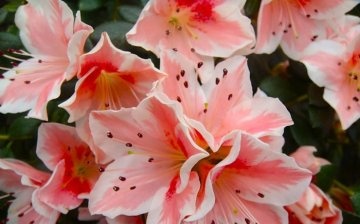









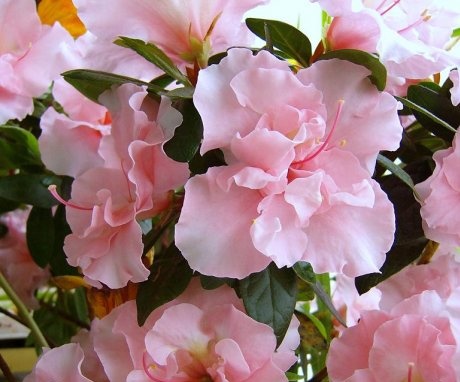
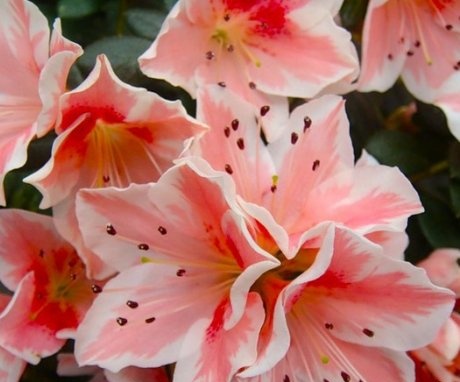
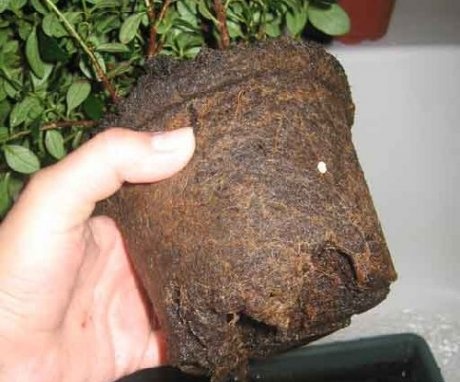
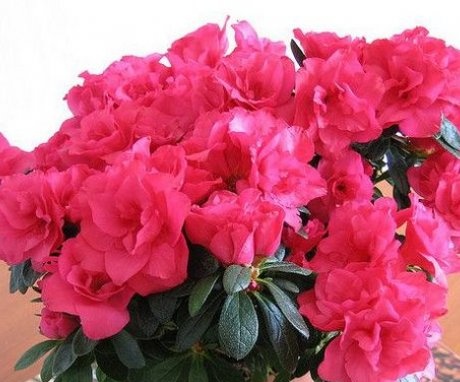

It is very beautiful when several varieties of azalea are grown in the garden at once. For example, at my mother's dacha "Hexe", "Niobe" and "Esmeralda" are growing. They bloom in March-April, and become the main decoration of the site.